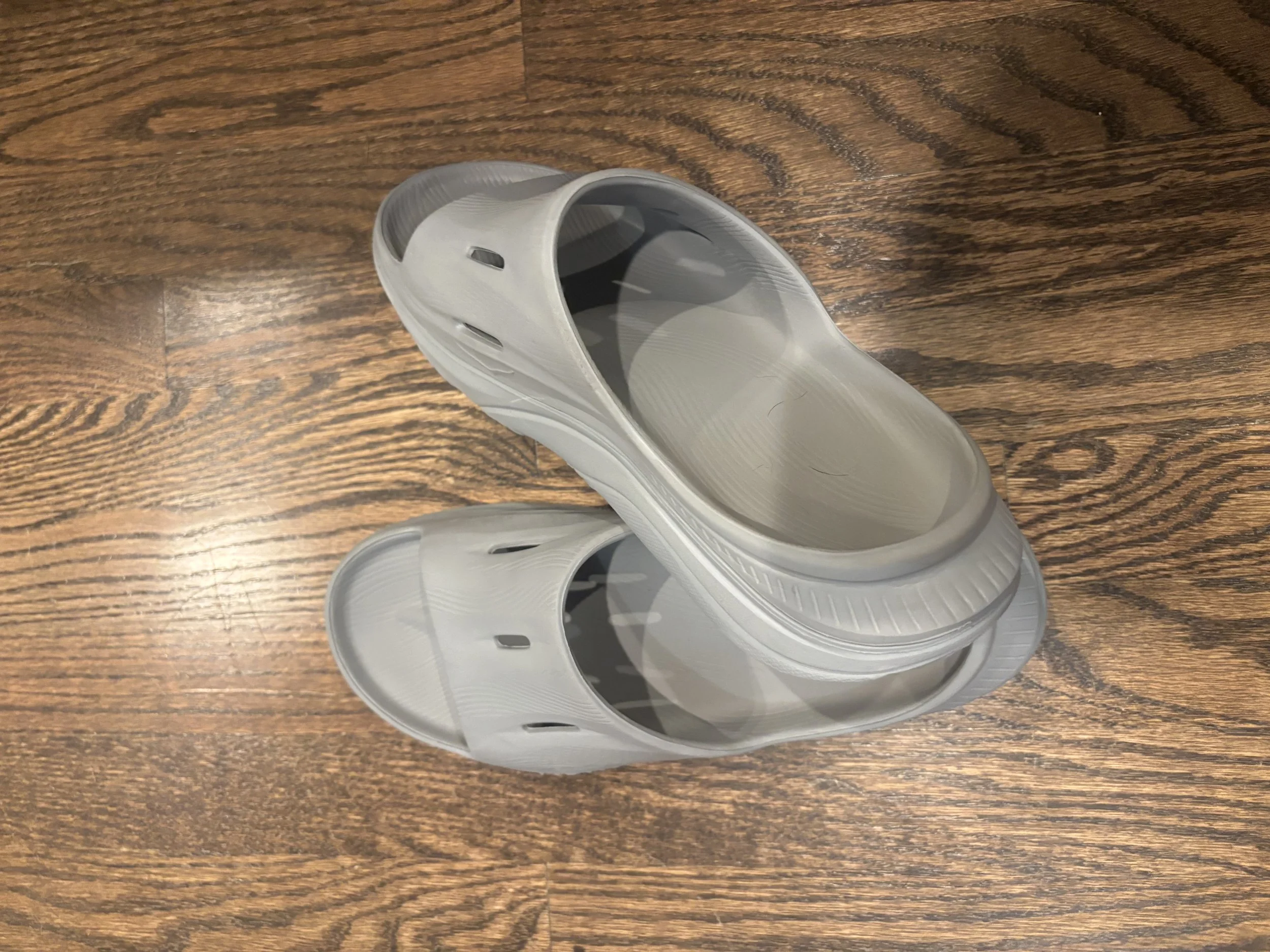Footwear Focus—A Podiatrist Reviews the Hoka Ora Recovery Slide
Recovery footwear has exploded in popularity over the past few years—and with good reason.
As a podiatrist and runner, I understand the importance of supporting your feet not just during activity, but in the hours that follow.
The right recovery shoe can make a noticeable difference in how your feet feel after long runs, workouts, or even long days on your feet.
That’s why, this month, I’m taking a closer look at the Hoka Ora Recovery Slide. This shoe has earned a loyal following among active adults and runners alike.
Full disclosure: this isn’t my first pair of Hokas. In truth, I wore my previous pair of these slides so much that I recently ordered a new pair because my old ones were falling apart. That alone should give you a hint about how much I’ve enjoyed them.
I’ve also heard about this model from patients, fellow runners, and even colleagues in the medical community. It’s marketed as the perfect “post-activity” slide—but how does it actually perform when put to the test?
Read on as I unpack what you should know about Hoka in general and why these slides have generated so much buzz.
Brand overview: What makes Hoka different
Hoka is a relatively young footwear company, founded in 2009 in Annecy, France.
From the start, Hoka set itself apart by embracing a maximalist design aesthetic—oversized midsoles and a rockered geometry that offered more cushioning than most shoes on the market.
What initially caught runners’ eyes about the brand soon turned into a solid, earned reputation for shoes that reduce impact and ease stress on the feet, legs, and joints—and do it without a heavy feel.
Over time, Hoka has expanded its foundational design philosophy into a broader mission.
If you’ve been following my Footwear Focus series, you know I try to feature brands that do more than make great shoes—I’m also looking for value-driven companies that are interested in giving back in real, meaningful ways.
To that end, Hoka emphasizes not only creating quality products but also folding in sustainability, corporate responsibility, and inclusion alongside a focus on performance.
A few highlights of the brand include:
Sustainable materials: Over 97% of Hoka’s footwear styles now include at least one preferred material (recycled, renewably sourced, or naturally derived) rather than relying purely on virgin plastics.
Packaging and environmental impact reduction: Hoka is working to eliminate plastics in its packaging and move toward FSC-certified or recycled paper and timber materials.
Ethical practices: The company joined the United Nations Global Compact in 2016, signaling a formal commitment to ethical practices around human rights, labor, climate, and transparency.
Corporate responsibility: Hoka uses a policy and principles framework that extends beyond minimum compliance. They apply these expectations to their production partners and aim to be accountable in areas like environmental footprint, workforce inclusion, and materials sourcing.
Inclusive values: Hoka states a belief that “running, walking, fitness, and the outdoors are for everyone” and emphasizes diversity, equity, and inclusion in how they represent athletes and design products.
In short: Hoka marries performance innovation with a growing focus on sustainability, ethical practices, and community.
A closer look at the Ora Recovery Slide
The Ora Recovery Slide takes the brand’s comfort-first approach to footwear and packages it in a casual, easy-on slide designed for recovery and relaxation.
Some of the standout features of this style include its:
Dual-density midsole: A combination of soft cushioning for comfort and a slightly firmer layer for stability.
Airflow channels: Perforations across the slide enhance breathability, which can be a nice feature after a sweaty run or workout.
Sugarcane EVA construction: A more sustainable midsole material, designed to keep things lightweight while maintaining structure.
Rockered sole profile: One of Hoka’s signature design elements, this is intended to support a smooth, rolling motion through each step.
APMA Seal of Acceptance: This seal from the American Podiatric Medical Association recognizes products that promote foot health.
Unlike traditional flip-flops or flat slides, the Ora Recovery Slide has noticeable cushioning and some contouring built into the footbed.
The heel is slightly elevated, and the rocker shape can help reduce the load on the plantar fascia and forefoot.
While it’s not a substitute for a fully supportive walking shoe, it offers a thoughtful balance between comfort and light structure.
What podiatrists and customers have to say
Among podiatrists, recovery slides like the Ora are often seen as a useful supplemental shoe, especially for people who are on their feet a lot or who need gentle, post-activity support.
So, they’re not meant to replace your main walking or running shoes, but they can help reduce strain during downtime, errands, or transitions between workouts and daily life.
The Ora Recovery Slide in particular has earned praise for its plush cushioning, rockered design, and overall comfort.
In particular, their rocker soles can make a meaningful difference for people who experience heel pain, plantar fasciitis, or general foot fatigue. By allowing the foot to roll more smoothly, they may help limit excessive pressure in sensitive areas like the heel and ball of the foot.
Many customers highlight how light and soft these slides feel. This softness, combined with the airflow channels, makes them a popular recovery footwear choice after long runs, walks, or workouts.
Some podiatrists are careful to note, however, that too much cushioning without enough structure can be problematic for certain foot types, especially if worn for extended periods.
For example, someone with significant overpronation or instability may not get the same level of support they’d receive from a structured walking shoe or custom orthotic insert.
Similarly, some customers also comment that the softness can feel “squishy” during longer wear, without the defined arch support of a dedicated support shoe.
The takeaway? Recovery slides can be an excellent tool—but like any footwear, they need to be matched to the right use case and foot type.
That’s why, if you’re considering a new footwear option, I’d be happy to help you select the right shoes for your unique anatomy and foot health needs.
Dr. Young reviews the Hoka Ora Slides
As I already mentioned, this isn’t my first go-round with the Hoka Ora Slides. In fact, they’ve been my favorite pair of recovery slides for years. I recently bought a new pair because I wore my old ones so often that they were falling apart.
Don’t worry, though—I’m basing my review on the new pair!
What do I like so much about these that they’re my longtime go-to recovery slide?
The short answer: plenty! But let me break it down for you and share some of my favorite features:
They’re very cushioned but also feel very supportive—a perfect balance.
They also feature Hoka’s Meta-Rocker technology, which is found in their running shoes. This boosts their place as a recovery shoe because they leverage similar biomechanics to a running shoe and aid in taking pressure off of crucial soft tissue structures.
The price is good, especially when you consider how these stack up against other similar styles I’ve tried. These run around $60.
They’re unisex and run true to size (I’m rocking mine in my usual size 9).
One potential drawback is these sandals aren’t the most aesthetically pleasing option on the market. Personally, I don’t mind wearing them around town, but I can imagine some folks wouldn’t want to. Then again, consider the popularity of Crocs and Uggs—aesthetics aren’t everything when it comes to footwear!
Bottom line: These sandals have earned a place in my regular rotation. The Hoka Ora Recovery Slide stands out for its cushioning, lightweight design, and rocker feature that gives your feet a break when they need it most. It’s a solid option for runners, walkers, and anyone looking for something more supportive than a typical flat slide or flip-flop.
Whatever foot health questions or concerns you’re facing, I’m here to support you. From helping you select the right footwear to providing innovative, personalized treatments, I created City Step Podiatry to offer you the trustworthy podiatry services you deserve in Chicago. Book easily online or stop by our convenient downtown location. And be sure to keep an eye on our blog and sign up for my email newsletter!
City Step Podiatry is here for you! Reach out today to schedule your visit and treat your feet to the care they deserve.









